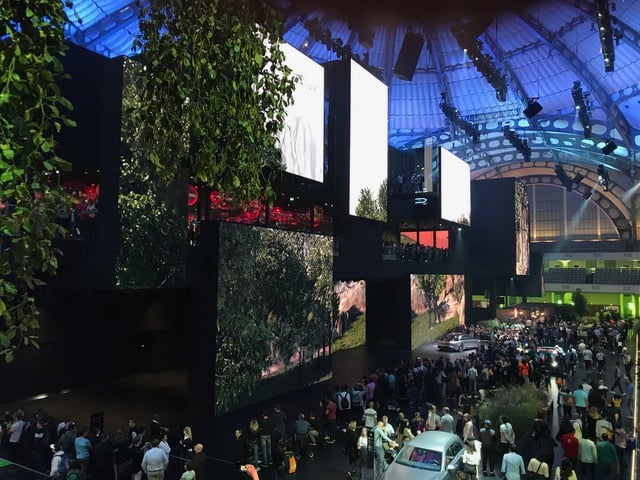Fifty Frames Pushes the Boundaries of Live Event Production with Help from AJA Gear
Trained to expect the unexpected, Fifty Frames (GmbH) Founder Christian Heinzel sees every live event production or installation as an opportunity to embrace emerging techniques and confront challenges head on. It’s something he puts into practice nearly every day as owner of a boutique shop that’s trailblazing 4K HDR and IP live event production and video streaming workflows for luxury car brands, bands, and major corporations across Europe. While his team is unafraid of a challenge, they’ve come to depend on AJA gear to provide a level of certainty in high pressure environments. It’s one of many reasons, Heinzel says, they regularly employ technology like AJA Ki Pro Ultra 12G recorders, FS-HDR real-time HDR/WCG converters, and KUMO 3232-12G SDI routers across projects.

Capturing the unseen: A secret UltraHD HDR recording
Fifty Frames recently covertly produced an UltraHD HDR concert for a German punk band, designed to prevent performance anxiety the band previously felt when made aware of concert recordings. The three-day event took place on a former airfield in Berlin and drew in an audience of more than 150,000 fans. Upon receiving the first stage and LED screen drawings, Heinzel realized the event’s massive scale. Recognizing the nontraditional nature of the concept and use of UltraHD screens, he opted to produce in UltraHD and tap into HDR to ensure more striking visuals.
“The lighting situation was quite complex, and we knew it would include changes from bright to dark and a lot of effects that you normally don’t see. SDR wasn’t an option because we’d need camera shaders all the time, whereas, with HDR, we knew that we’d get a bigger dynamic range so we could see all the light, but it wouldn’t come across as overexposed,” he explained.
Due to the clandestine nature of the recording, his team strategically placed the ten remote and broadcast grade cameras out of the band’s sight lines. Over the course of the three-day production, the team collectively captured 75 terabytes of footage from the cameras using 14 AJA Ki Pro Ultra 12Gs. “The Ki Pro Ultra 12G was an easy choice,” Heinzel recalled. “It’s reliable, affordable, and flexible. I can record eight HD camera feeds with just two units, saving rack space. Plus, I don’t need a specialist to operate it.”
Heinzel’s team then color matched the mix of remote and broadcast grade cameras using AJA FS-HDR. Heinzel noted, “FS-HDR is an absolutely brilliant tool for color matching cameras; it’s truly a Swiss Army knife for color conversion.”

Finding unique solutions to unique challenges
Heinzel and his team have tackled many other outside-the-box productions as well. While previously working on an HDR live event project for a major car brand in Frankfurt, they realized their media servers only had HDMI and display port outputs, so they couldn’t transport the HDR signal. Together, Heinzel and his colleague Oliver Derynck came up with a solution: if they could convert the signals of the media server to 12G-SDI and run it through an FS-HDR, they could then tell the signal it was HDR and run it through the switcher. “We tested it out, and it worked, so we were able to retain the HDR metadata,” Heinzel explained. “FS-HDR helped provide a simple solution to a really complex challenge.”
For the occasional augmented reality (AR) project Heinzel’s team encounters, he’s built custom real-time rendering machines with integrated AJA Corvid 44 12G cards for I/O. “We’ve done a few AR projects with Zero Density, and they’re a lot of fun, even though the workflow is different,” he explained. “Our systems for these are presently baseband SDI, but the goal is to move them to SMPTE ST 2110.”
Marching toward an IP future
As Fifty Frames continues to innovate across client productions and studio installs, Heinzel is looking to SMPTE ST 2110 to simplify the transport of uncompressed media. He noted, “SMPTE ST 2110 will enable us to work with high bandwidth media as we would with SDI, with no compression, while introducing many benefits, from a reduction in equipment to substantial power and performance gains. Less equipment means a lighter load for travel, and with the right IP router, I can easily get 400 UltraHD signals using a 1RU device, which is amazing. Next year, I think we’re going to see a lot more SMPTE ST 2110 products surface.”
For the time being, he plans to continue maximizing his KUMO 3232-12G SDI routers to support routing needs across projects. Heinzel concluded, “KUMO 3232-12G provides an affordable way for us to get signals where they need to go, whether to the shaders or for monitoring needs; it does what it’s supposed to do well, and it’s reliable. The usability is also perfect. You don’t have to study the manual in-depth to operate it. That’s important because my team doesn’t have time to fiddle around with equipment. We need our gear to work.”